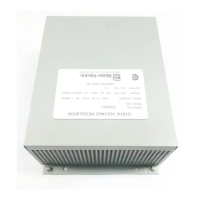2-2
support. See Figure 3-2 for a typical interconnection diagram. This scheme uses the other contact
on the buildup relay to connect dc voltage from the exciter armature directly to the exciter field. As
an alternative, the regulator could be used as described in paragraph 2-3a. with an excitation support
system accessory.
a.
Reactive Droop Compensation (Droop) or Reactive Differential Compensation
(Cross-Current)
(1) Parallel operation requires additional components in the regulating system. These are resistor
R25, transformer T3 and a current transformer CT1. Two of the components are included in a
parallel equipped voltage regulator. These are R25 and T3. Current transformer CT1 is a separate
item and must be interconnected as shown in Figures 3-2 or 3-3.
(2) These components allow the paralleled generators to share reactive load and reduce circulating
reactive currents between them. This is accomplished in the following manner.
(3) A current transformer CT1 is installed in phase B of each generator. It develops a signal that is
proportional in amplitude and phase to the line current. This current signal develops a voltage
across resistor R25. A slider on R25 supplies a part of this voltage to the primary of the transformer
T3. The secondaries of T3 are connected in series with the leads from the secondary of the sensing
transformer T1, and the sensing rectifiers located on the printed circuit board. The ac voltage
applied to the sensing rectifier bridge is the vector sum of the stepped down sensing voltage
(terminals E1 and E3) and the parallel CT signal supplied through T3 (terminals 1 and 2). The
voltage supplied to the sensing rectifiers by the parallel CT is very small in relation to the signal
supplied by the sensing voltage. The regulator input sensing voltage (terminals E1 and E3) and the
parallel compensation signal (terminals 1 and 2) must be connected to the generator system so as to
provide the correct phase and polarity relationship.
(4) Regulators with single-phase sensing provide about 8% maximum droop while three-phase
sensing regulators provide 6% droop. When generators are paralleled on the same bus and have
different type sensing, care must be taken to compensate for these differences using the slide wire
adjustment on the droop resistor R25.
(5) When a resistive load (unity P.F) load is applied to the generator, the voltage that appears across
R25 (and T3 windings), leads the sensing voltage by 90
°
, and the vector sum of the two voltages is
nearly the same as the original sensing voltage; consequently, almost no change occurs in generator
output voltage.
(6) When a lagging power (inductive) load is applied to the generator, the voltage across R25
becomes more in phase with the sensing voltage and the combined vectors of the two voltages
results in a larger voltage being applied to the sensing rectifiers. Since the action of the regulator is
to maintain a constant voltage at the sensing rectifiers, the regulator reacts by decreasing the
generator output voltage.
3$5$//(/&203(16$7,21

